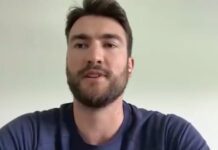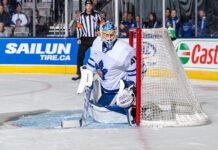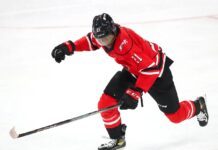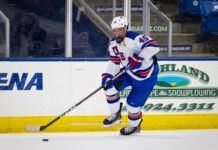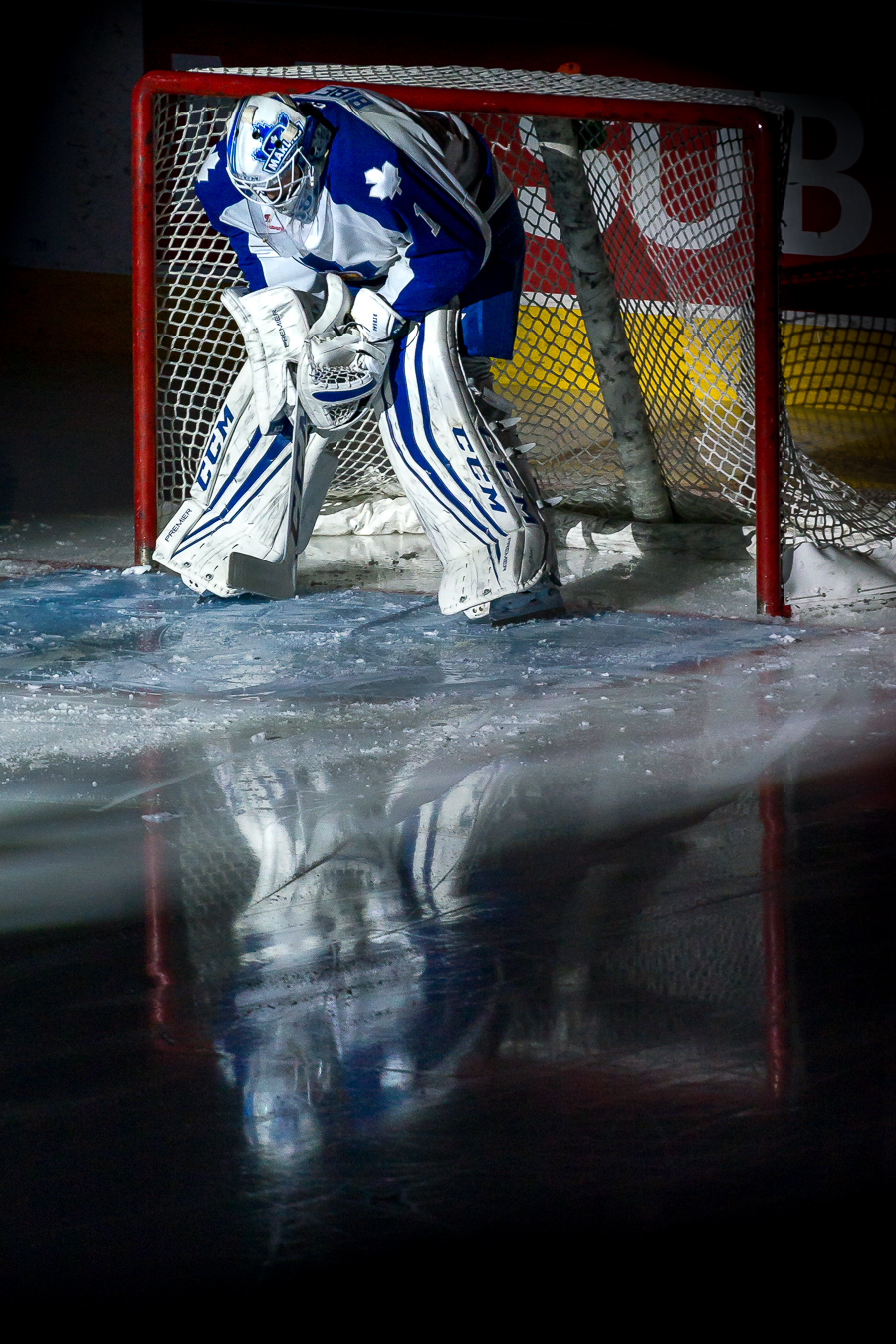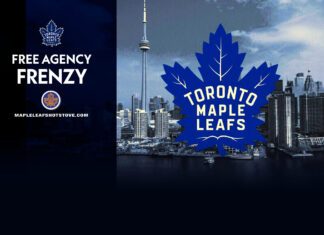Could one of the Toronto Marlies’ perceived weakness heading into the post-season actually turn into one of their greatest strengths?
Two young goaltenders with less than 80 minutes of playoff experience between them might appear to other teams as a vulnerable area to target — a chink in the armour for a Toronto team with a potent offense and bottomless roster resources.
Of the 19 goaltenders to have received a start so far during the 2016 Calder Cup campaign, about eight fit the definition of “experienced.” The Hershey Bears have the well-traveled duo of Justin Peters and Dan Ellis between the pipes. Mike McKenna (Portland), Richard Bachman (Utica), and Jeremy Smith (Providence) round out the seasoned netminders in the East. In the West, San Diego are backstopped by Anton Khudobin, Grand Rapids are reliant on Tom McCollum, while Ontario Reign lean on the incomparable Peter Budaj, who has had himself a dominant season back in the AHL.
Five rookies have played in the first round, with Joonas Korimako (Lake Erie Monsters) and Casey DeSmith (Wilkes-Barre/Scranton Penguins) leading their teams to victorious sweeps.
WBS Pens also have another rookie in Tristan Jarry who should play some part in the second round. Ability and form appear to be more valued qualifications in goaltenders than age and experience in this season’s playoffs. Certainly Antoine Bibeau and Garret Sparks have shown that to be the case in the early going for Toronto.
It created quite the stir on social media when Bibeau was given the nod ahead of Sparks for game one, but it really shouldn’t have when you consider how consistently strong the Quebec native was down the stretch. The pressure was on the 2013 draft pick to perform, having been overlooked for the most part this season by the Leafs, with his one foray into the NHL resulting in clipboard duty on the bench. He rose to the occasion.
Sparks, meanwhile, received two recalls, winning three of his four starts in the first.
The second callup, after trade deadline following James Reimer‘s exit, resulted in the Illinois native spending the remainder of the season in the NHL. This came despite Lou Lamoriello’s insistence that the organization wanted a look at its young goaltenders — a statement that seemingly indicated an upcoming opportunity for both Marlie regulars, but Bibeau was overlooked the rest of the way as far as the big club was concerned.
He was, however, presented the opportunity to run with the ball in the American Hockey League. In his sophomore season, Bibeau began the year well, but he battled with consistency. In hindsight, the infamous 9-8 overtime victory in St. John’s may have taken a mental toll (game #7 in the chart below).
[wpdatachart id=45]
Whatever the issues, Bibeau has put them well behind him and has certainly stepped up after the moment he was made the clear number one at the trade deadline. With a 9-4-1-0 record since the deadline — including three shutouts, with a 35-save effort in Albany the best of the efforts — Bibeau performed better as the playoffs came into view. He won seven of his last eight and registered a .937 save percentage over that period. It was of little surprise to me, then, when Sheldon Keefe gave him the nod for game one. Bibeau had simply earned the opportunity to keep the net.
This is not to downplay the efforts of Garret Sparks this season. Sparks was excellent for the most part during his shortened season in the AHL. In 21 starts, he produced three shutouts, with a 39-save effort in Grand Rapids his best performance of the year. He was pulled in one start against Hershey after allowing three goals in eleven shots on home ice; that was one of about four starts that weren‘t up to snuff, but when on his game — as he was far more often than not — Sparks was reliably excellent.
[wpdatachart id=46]
After opening his NHL account by becoming the first Toronto Maple Leaf goaltender to record a shutout on debut, Sparks undoubtedly struggled in his second stretch with the Leafs as the season came to a close. You would, of course, expect an NHL rookie to face some struggles at some point, especially behind a stripped-down team like the second-half 2016 Leafs. But when it became apparent Sparks was in over his head, Leafs brass, without much in the way of options, let Sparks falter longer than he should have. He wore it in his body language during games, and in his voice and facial expressions in post-game scrums after losses.
To his credit, the 2011 draft pick instantly bounced back from a tough finish in the NHL by preforming at a high-level in the last AHL game of the regular season. Playing behind a hotchpotch Marlies team made up mostly of junior and college players, he stopped 45 of 47 shots to earn the win against Rochester. Then, after sitting out game one, Spaks responded emphatically to Antoine Bibeau’s fantastic outing in game one of the series versus Bridgeport, recording a shutout in game two. His 31 saves weren’t as demanding as Bibeau’s, with Toronto giving up fewer high-quality scoring opportunities to their opponent, but his positional play, rebound control and handling of the puck were sound and his game looks in fine order at this stage.
If I were to guess, it seems likely Bibeau will be given the nod for game three. Without trying to jinx the series, it would be a huge surprise if Toronto does not complete the job on Thursday. But it’s likely just the beginning of the goaltending carousel in the Marlie net this playoff. The younger Bibeau may well hold the upper hand at this juncture, but you feel that one poor performance from either will present the other with the starting job the next game.
It’s quite possible that, with the nature of the Calder Cup playoffs, the two could continue to split starts for a while yet. Back-to-backs are routine, as are two games in three days with travel involved. Keeping both goaltenders fresh and giving both opportunities doesn’t just benefit the two individuals involved by getting them invaluable big-game experience; it’s seemingly the prudent thing to do for a Marlies team that’s sizing up a deep run and has a pair of goalies playing well at the right time of year, without much separating the two.
It’s an uncommon situation for Marlies fans, who are used to the team running with one goaltender during the post-season — think Ben Scrivens, Drew MacIntyre and the slightly-unusual decision to ride Christopher Gibson last Spring. A ‘1A and 1B’ situation might cause issues and discomfort for some teams and coaches, but it doesn’t appear to bother Sheldon Keefe, whose Marlies team increasingly looks well taken care of at a very important position.


